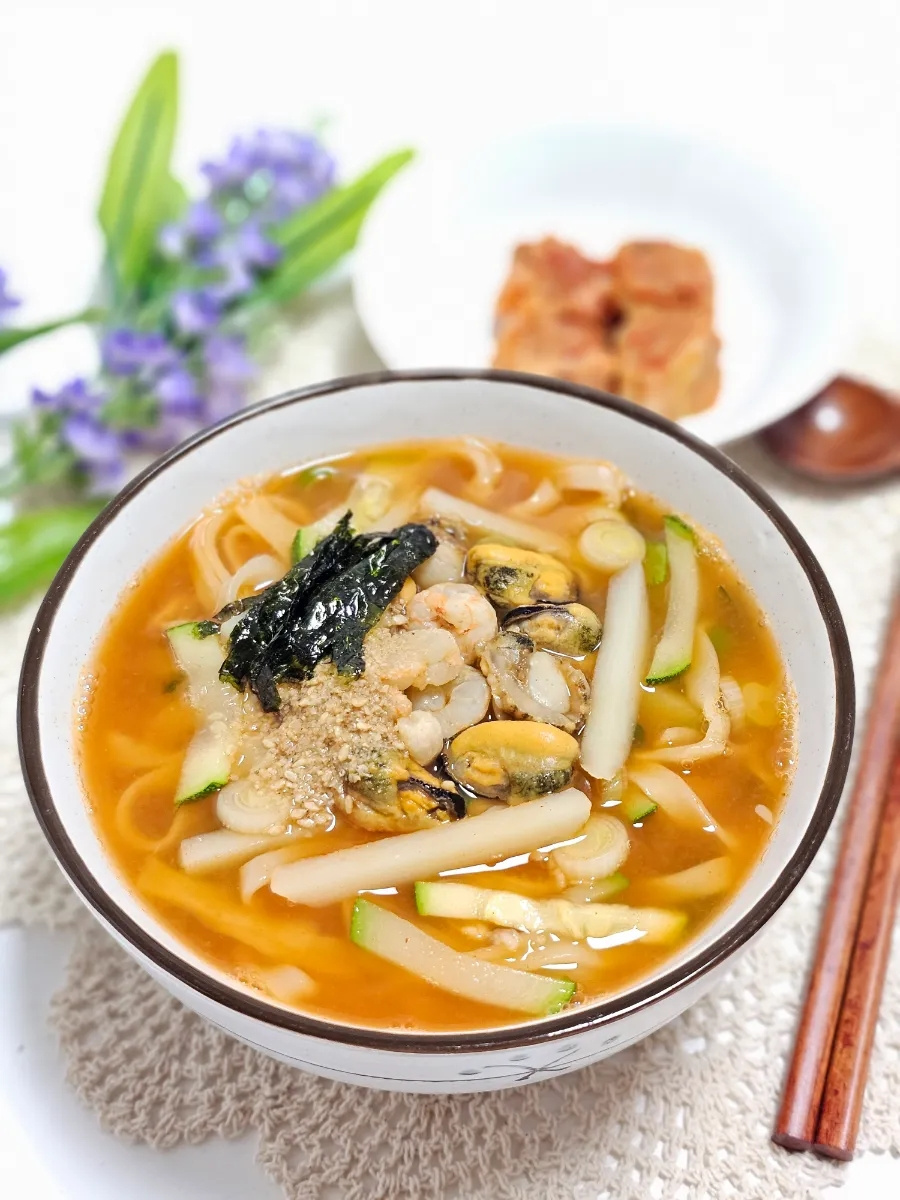Spicy Jang-Kalguksu (Noodle Soup with Gochujang and Doenjang)
How to Make Jang-Kalguksu: A Delicious Noodle Soup with Gochujang and Doenjang

Enjoy a hearty and flavorful bowl of Jang-Kalguksu, a Korean noodle soup seasoned with a savory blend of gochujang (Korean chili paste) and doenjang (fermented soybean paste). This recipe balances spicy, savory, and slightly sweet notes for a truly satisfying meal.
Main Ingredients- 2 servings Kalguksu noodles
- 1/2 potato, cut into thick matchsticks
- 1 piece zucchini, cut into thick matchsticks (or half-moons)
- 1 stalk green onion, diagonally sliced
- 7 cups anchovy-kelp broth
- A little shredded dried seaweed (garnish)
- A little toasted sesame seeds (garnish)
Seasoning- 2 Tbsp Gochujang (Korean chili paste)
- 1/2 Tbsp Doenjang (fermented soybean paste)
- 1 Tbsp Fish sauce (or Korean soup soy sauce)
- 1/2 Tbsp Minced garlic
- 2 Tbsp Gochujang (Korean chili paste)
- 1/2 Tbsp Doenjang (fermented soybean paste)
- 1 Tbsp Fish sauce (or Korean soup soy sauce)
- 1/2 Tbsp Minced garlic
Cooking Instructions
Step 1
Prepare 7 cups of savory anchovy-kelp broth. For a deeper flavor, you can add anchovies, kelp, onion, and green onions while simmering. Using store-bought broth packs or bouillon cubes is also a convenient option. Kalguksu typically requires more broth than instant ramen, so prepare it generously.

Step 2
In the prepared anchovy broth, dissolve 2 tablespoons of gochujang and 1/2 tablespoon of doenjang. To ensure a smooth texture, it’s best to strain the doenjang through a fine sieve before adding it to prevent lumps. Be mindful not to add too much doenjang, as it can make the soup taste like a heavy soybean paste stew. A small amount is perfect for balancing the flavors.

Step 3
Get your 2 servings of kalguksu noodles ready. Store-bought kalguksu noodles are often coated with starch to prevent them from sticking together. While this helps during storage, it can make the soup cloudy if added directly. To achieve a clearer broth, briefly rinse the noodles under cold running water just before cooking to remove excess starch.

Step 4
Peel the 1/2 potato and cut it into thick matchsticks, about 0.5 cm thick. Alternatively, you can slice it into thin half-moons if you prefer.

Step 5
Cut the piece of zucchini into thick matchsticks, similar in size to the potatoes. This adds a pleasant texture and a subtle sweetness to the broth. You can also slice it into half-moons.

Step 6
Diagonally slice the stalk of green onion. This will add a fragrant aroma and a touch of freshness to the finished dish, enhancing its visual appeal.

Step 7
Rinse 1 cup of frozen mixed seafood thoroughly under cold water. Using a variety like squid, mussels, clams, and shrimp will make your Jang-Kalguksu even more delicious. Frozen seafood is often pre-cooked, so just pick out any shells or impurities and give them a gentle rinse.

Step 8
Once the broth starts boiling, add the rinsed mixed seafood and the thick matchsticks of potato. Adding the potatoes now allows them to cook evenly with the noodles and seafood.

Step 9
After adding the seafood and potatoes, put in the kalguksu noodles, which you’ve lightly rinsed to remove excess starch. Adding the noodles without rinsing might make the broth murky and thick.

Step 10
Cooking the potatoes along with the noodles ensures they are perfectly tender by the time the noodles are done. If you were to cook the potatoes separately beforehand, they might become overcooked and mushy when added with the noodles. Cooking them together in one pot is the ideal method.

Step 11
When the noodles are partially cooked, add 1 tablespoon of fish sauce (or Korean soup soy sauce) and 1/2 tablespoon of minced garlic to season. Taste the soup and adjust the seasoning as needed, as the saltiness of gochujang and doenjang can vary. Add more fish sauce or salt if it’s bland, or a little water or broth if it’s too salty.

Step 12
Skim off any foam that rises to the surface while the soup is cooking. This step helps to create a clearer and cleaner broth, enhancing the overall flavor of the Jang-Kalguksu.

Step 13
Once the kalguksu noodles are fully cooked and all the ingredients are well combined, add the julienned zucchini and sliced green onions. Let it simmer for another moment until the zucchini is tender-crisp. Avoid overcooking them, as they can become too soft.

Step 14
Serve the hearty Jang-Kalguksu in bowls. Garnish with shredded dried seaweed and toasted sesame seeds, if desired. Enjoy this warm, spicy, and deeply satisfying noodle soup!



